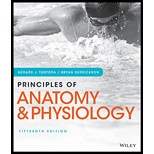
Principles of Anatomy and Physiology
15th Edition
ISBN: 9781119329398
Author: Gerard J Tortora, Bryan Derrickson
Publisher: John Wiley & Sons Inc
expand_more
expand_more
format_list_bulleted
Question
Chapter 14, Problem 12CP
Summary Introduction
To review:
The reason for considering the hypothalamus a part of both the endocrine and nervous systems.
Introduction:
A component of the diencephalon, the hypothalamus, is a major part of the limbic system. It is located below the thalamus, just behind the optic chiasma (the point where the left and right optics nerve intersect). It consists of four major regions, namely mammillary region, tubular region, supraoptic region, and preoptic region. Though very small in size, it performs a multitude of functions.
Expert Solution & Answer
Want to see the full answer?
Check out a sample textbook solution
Students have asked these similar questions
Briefly state the physical meaning of the electrocapillary equation (Lippman equation).
Explain in a small summary how:
What genetic information can be obtained from a Punnet square? What genetic information cannot be determined from a Punnet square?
Why might a Punnet Square be beneficial to understanding genetics/inheritance?
In a small summary write down:
Chapter 14 Solutions
Principles of Anatomy and Physiology
Ch. 14 - Compare the sizes and locations of the cerebrum...Ch. 14 - Prob. 2CPCh. 14 - Prob. 3CPCh. 14 - Prob. 4CPCh. 14 - Prob. 5CPCh. 14 - 6. Where are the medulla, pons, and midbrain...Ch. 14 - Prob. 7CPCh. 14 - Prob. 8CPCh. 14 - Describe the location and principal parts of the...Ch. 14 - 10. Where do the axons of each of the three pairs...
Ch. 14 - Prob. 11CPCh. 14 - Prob. 12CPCh. 14 - Prob. 13CPCh. 14 - Define a circumventricular organ.Ch. 14 - 15. List and locate the lobes of the cerebrum. How...Ch. 14 - Prob. 16CPCh. 14 - Prob. 17CPCh. 14 - Prob. 18CPCh. 14 - Prob. 19CPCh. 14 - Prob. 20CPCh. 14 - Prob. 21CPCh. 14 - Prob. 22CPCh. 14 - How are cranial nerves named and numbered?Ch. 14 - Prob. 24CPCh. 14 - Prob. 25CPCh. 14 - Prob. 26CPCh. 14 - Prob. 27CPCh. 14 - Prob. 28CPCh. 14 - Prob. 29CPCh. 14 - Prob. 30CPCh. 14 - Prob. 31CPCh. 14 - Prob. 32CPCh. 14 - Prob. 33CPCh. 14 - 34. Where do the motor axons of the accessory (XI)...Ch. 14 - Prob. 35CPCh. 14 - Prob. 36CPCh. 14 - Prob. 37CPCh. 14 - An elderly relative suffered a CVA (stroke) and...Ch. 14 - Prob. 2CTQCh. 14 - 3. You have been hired by a pharmaceutical company...
Knowledge Booster
Learn more about
Need a deep-dive on the concept behind this application? Look no further. Learn more about this topic, biology and related others by exploring similar questions and additional content below.Similar questions
- Not part of a graded assignment, from a past midtermarrow_forwardNoggin mutation: The mouse, one of the phenotypic consequences of Noggin mutationis mispatterning of the spinal cord, in the posterior region of the mouse embryo, suchthat in the hindlimb region the more ventral fates are lost, and the dorsal Pax3 domain isexpanded. (this experiment is not in the lectures).a. Hypothesis for why: What would be your hypothesis for why the ventral fatesare lost and dorsal fates expanded? Include in your answer the words notochord,BMP, SHH and either (or both of) surface ectoderm or lateral plate mesodermarrow_forwardNot part of a graded assignment, from a past midtermarrow_forward
- Explain in a flowcharts organazing the words down below: genetics Chromosomes Inheritance DNA & Genes Mutations Proteinsarrow_forwardplease helparrow_forwardWhat does the heavy dark line along collecting duct tell us about water reabsorption in this individual at this time? What does the heavy dark line along collecting duct tell us about ADH secretion in this individual at this time?arrow_forward
arrow_back_ios
SEE MORE QUESTIONS
arrow_forward_ios
Recommended textbooks for you
 Human Physiology: From Cells to Systems (MindTap ...BiologyISBN:9781285866932Author:Lauralee SherwoodPublisher:Cengage Learning
Human Physiology: From Cells to Systems (MindTap ...BiologyISBN:9781285866932Author:Lauralee SherwoodPublisher:Cengage Learning Human Heredity: Principles and Issues (MindTap Co...BiologyISBN:9781305251052Author:Michael CummingsPublisher:Cengage Learning
Human Heredity: Principles and Issues (MindTap Co...BiologyISBN:9781305251052Author:Michael CummingsPublisher:Cengage Learning Comprehensive Medical Assisting: Administrative a...NursingISBN:9781305964792Author:Wilburta Q. Lindh, Carol D. Tamparo, Barbara M. Dahl, Julie Morris, Cindy CorreaPublisher:Cengage Learning
Comprehensive Medical Assisting: Administrative a...NursingISBN:9781305964792Author:Wilburta Q. Lindh, Carol D. Tamparo, Barbara M. Dahl, Julie Morris, Cindy CorreaPublisher:Cengage Learning Concepts of BiologyBiologyISBN:9781938168116Author:Samantha Fowler, Rebecca Roush, James WisePublisher:OpenStax College
Concepts of BiologyBiologyISBN:9781938168116Author:Samantha Fowler, Rebecca Roush, James WisePublisher:OpenStax College

Human Physiology: From Cells to Systems (MindTap ...
Biology
ISBN:9781285866932
Author:Lauralee Sherwood
Publisher:Cengage Learning


Human Heredity: Principles and Issues (MindTap Co...
Biology
ISBN:9781305251052
Author:Michael Cummings
Publisher:Cengage Learning


Comprehensive Medical Assisting: Administrative a...
Nursing
ISBN:9781305964792
Author:Wilburta Q. Lindh, Carol D. Tamparo, Barbara M. Dahl, Julie Morris, Cindy Correa
Publisher:Cengage Learning

Concepts of Biology
Biology
ISBN:9781938168116
Author:Samantha Fowler, Rebecca Roush, James Wise
Publisher:OpenStax College
Great Glands - Your Endocrine System: CrashCourse Biology #33; Author: CrashCourse;https://www.youtube.com/watch?v=WVrlHH14q3o;License: Standard Youtube License